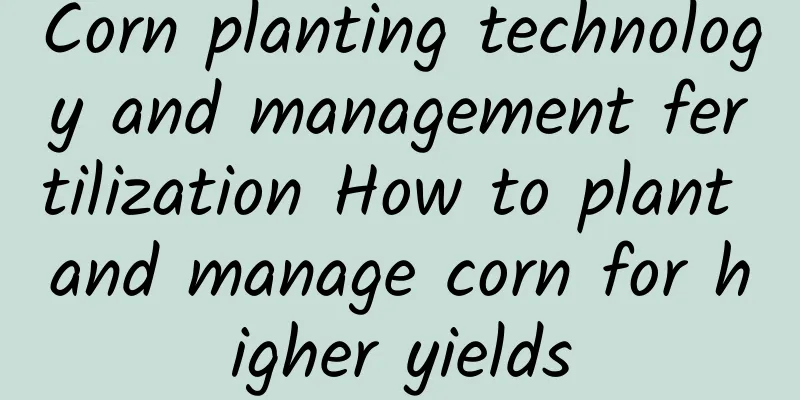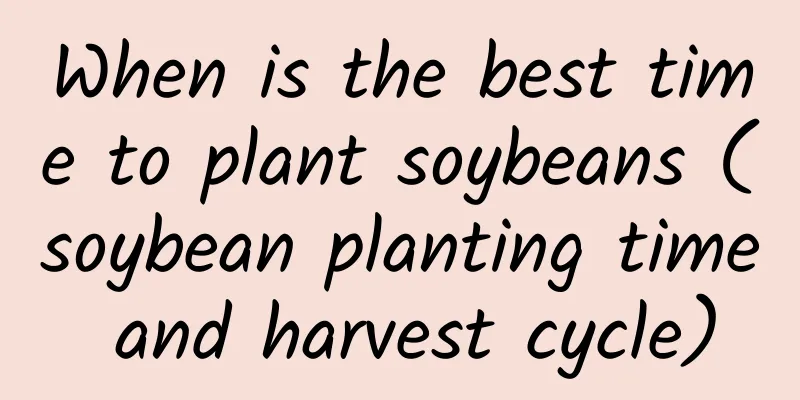Corn planting technology and management fertilization How to plant and manage corn for higher yields

|
If you want to grow corn with high yield, you need to plant carefully, manage scientifically, and invest reasonably. At the same time, you need to understand the sowing time, growth cycle, fertilization method, etc. of corn before configuration. As long as you learn the correct management method, it is difficult for corn not to have high yield. Preparation before sowing1. Site selection and land preparation Choose an area with an altitude of 500-1300 meters, a purple soil type, a soil pH of 6.5-7, no shade around, and facing the sun. Try to choose a flat terrain with a deep soil layer, good soil quality, and uniform soil fertility. When planting, pay attention to water and fertilizer conservation, convenient irrigation and drainage, and soil organic matter content. 2. Select seeds and seed treatment Before sowing, the seeds should be carefully selected to remove the shriveled, small, and unqualified seeds. After the seeds are carefully selected, the germination rate should be tested 15 days before sowing. 3-5 days before sowing, choose a windless and sunny day and spread the seeds in a dry and sunny place for 2-3 days. Precision sowing1. Sowing period In spring , when the temperature is stable above 12℃, sowing can be done . In flat areas and shallow hilly areas, sowing is generally done in mid-to-early March , while in deep hilly and medium and low mountainous areas , sowing and raising seedlings is best done in late March or early April , in order to shorten the wheat-corn symbiosis period and cultivate strong seedlings. 2. Seedling cultivation When using fertilizer balls or special corn seedling trays to raise seedlings , a certain proportion of fully decomposed organic fertilizer and a small amount of superphosphate should be added to the nutrient soil. However, urea or ammonium bicarbonate should not be added to prevent seed rot. Then, keep the nutrient soil loose to provide the necessary nutrients and water for the growth of seedlings. 3. Transplanting Before transplanting, you should take advantage of the sunny weather, expose the mulch to ventilate and harden the seedlings for 1 to 2 days, then gradually uncover the mulch for 1 to 2 days. When the seedlings have 2 leaves and 1 heart, start transplanting. It is strictly forbidden to plant old and large seedlings. When transplanting, transplant single plants or double plants in staggered holes according to density requirements, so that the holes are large and flat. Select strong seedlings of the same age and vigor. Try not to damage the roots when transplanting the seedlings so that the young plants can quickly turn green. The suitable planting density is about 3500-4000 plants/mu , and the seedlings should be planted deep , 5 cm below the soil surface, and the soil should not be pressed down after mulching. After planting, use a scoop of clear manure water to water the " rooting water ". Scientific fertilization1. Nitrogen It is basically stable throughout the growth period, with slight fluctuations in the middle. It usually reaches its peak at the tasseling and silking stage, and gradually decreases from the beginning of grain filling to the maturity stage, but corn absorbs nitrogen throughout the growth period. If nitrogen is deficient, the leaves of the plant will turn yellow , growth will slow down, the plant will be short, and the tips of the lower leaves will turn yellow. 2. Phosphorus Corn also absorbs phosphorus throughout the growth period. Like nitrogen fertilizer, it reaches a peak during the tasseling and silking stage. Then it decreases, but the phosphorus requirement in the later stage is also about one-third. If phosphorus is deficient, the leaves will turn yellow, brown spots will appear, and dry leaves will appear. 3. Potassium The potassium content of corn will gradually increase from the jointing stage to the booting stage, and will reach the highest point during the flowering stage. After that, the potassium content will decrease due to the external infiltration. If potassium is deficient, the center of old and new leaves will have an old green color, and the leaf tips and edges will turn yellow or even necrotize. There will even be a clear dividing line, and the leaves of corn will bend. |
<<: When is the best time to repot succulent plants?
Recommend
How to grow roses
1. Breeding environment 1. Soil: Choose soil suit...
How to care for lilies after they bloom?
Lily is a flower that many people like to grow. L...
Advantages and disadvantages of Red Diamond Rose
The Red Diamond Rose is also called the Red Emper...
How to raise dogtail red
1. Maintenance methods 1. Temperature: As can be ...
The difference between foxtail orchid and nail orchid
1. Different species Because they are of differen...
When is the best time to sow celery seeds?
Celery seed sowing time Celery can be sown in spr...
The breeding method of the ten merits
1. Maintenance methods 1. Temperature: 20 to 28 d...
How to survive the winter in northern ground-planted roses (wintering cultivation techniques for outdoor ground-planted roses)
How low of a temperature can roses withstand Diff...
The main value of Amomum villosum
Ornamental value This is of course a value that m...
The Difference Between Lantana and Verbena
1. Different varieties Lantana is a plant belongi...
How to trim the pine trees to look good
When is the best time to prune pine? Pinus armeni...
Does the fortune tree like the sun?
Money tree likes the sun The money tree likes the...
“Tiger Piranha” not growing vigorously? Why not try these "3 tricks" to make the leaves green and lush and fill the entire pot!
Loosen the soil in time The Sansevieria hasn'...
Can Michelia be grown indoors?
1. Is it suitable for indoor breeding? The answer...
Reasons and countermeasures for osmanthus not blooming
1. Poor sleep Osmanthus flowers need to be brough...









